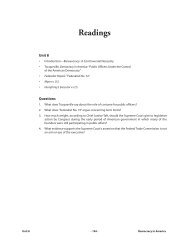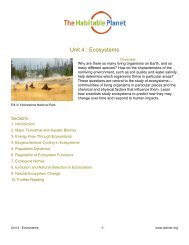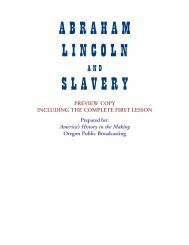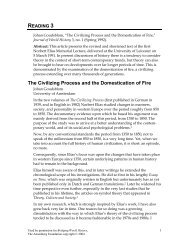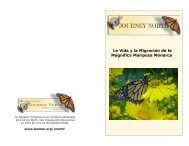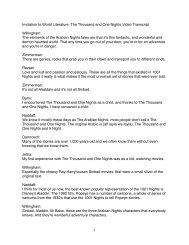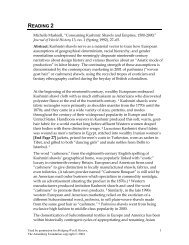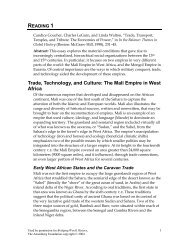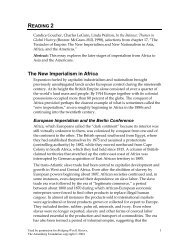UTOPIAN PROMISE - Annenberg Media
UTOPIAN PROMISE - Annenberg Media
UTOPIAN PROMISE - Annenberg Media
You also want an ePaper? Increase the reach of your titles
YUMPU automatically turns print PDFs into web optimized ePapers that Google loves.
the era. The curriculum materials help fill in the<br />
video’s introduction to early articulations of “the<br />
promised land” by exploring writers who represent<br />
other, diverse traditions, such as Samson Occom (a<br />
Native American Calvinist minister), William<br />
Bradford (a Separatist Puritan), Thomas Morton<br />
(an Anglican protestor of Puritan doctrine), and<br />
many others.<br />
The video, the archive, and the curriculum materials<br />
contextualize the writers of this era by examining<br />
several key stylistic characteristics and religious<br />
doctrines that shape their texts: (1) the role of typology—the<br />
Puritans’ understanding of their lives as<br />
the fulfillment of biblical prophecy on both a communal<br />
and an individual level; (2) the importance of<br />
plain style—a mode of expression characterized by<br />
simplicity, accessibility, and the absence of ornament—in<br />
Puritan and Quaker speech, writing,<br />
clothing, architecture, furniture, and visual arts;<br />
(3) the diversity of Puritan and Quaker attitudes<br />
toward and ways of interacting with Native<br />
Americans; (4) the centrality of the Apocalypse, or<br />
the end of the world as it is prophesied in the Book<br />
of Revelation, to Puritan thought; and (5) the relevance<br />
of weaned affections—the idea that individuals<br />
must learn to wean themselves from earthly<br />
loves and focus only on spiritual matters—as a theological<br />
doctrine.<br />
The archive and curriculum materials suggest<br />
how students might connect the readings in this<br />
unit to those in other units in the series. Students<br />
might ask, for example, Why are the Puritans considered<br />
such an important starting point for<br />
American culture and literature? Why do later writers<br />
such as Nathaniel Hawthorne and Louise<br />
Erdrich invoke the Puritans in their own work?<br />
How do Rowlandson’s and Penn’s perceptions of<br />
Native Americans compare to Christopher<br />
Columbus’s, Thomas Harriot’s, and John Smith’s<br />
perceptions? How do the Native American perspectives<br />
offered in Unit 1 complicate Puritan and<br />
Quaker understandings of Indian culture? Why<br />
does Winthrop’s metaphor of the “City on a Hill”<br />
resonate so deeply in American culture? How are<br />
the Utopian visions of the writers in Unit 3 adopted,<br />
reformulated, or undermined in the work of writers<br />
presented in later units?<br />
4 UNIT 3, <strong>UTOPIAN</strong> <strong>PROMISE</strong><br />
Student Overview<br />
Unit 3, “The Promised Land,” explores the literatures<br />
and cultures produced by the different<br />
European and Native American groups who inhabited<br />
the eastern shores of North America in the<br />
seventeenth and eighteenth centuries. Many of the<br />
immigrant groups discussed in this unit—Puritans,<br />
Quakers, Anglicans, and others— arrived in the<br />
“New World” with optimistic plans for creating<br />
model societies that would fulfill God’s will on earth.<br />
Most groups almost immediately encountered challenges<br />
that threatened those plans. The physical difficulties<br />
of living in an unfamiliar land, friction with<br />
other immigrant groups, dissent within their<br />
own communities, and conflicts with Native Americans<br />
complicated and undermined their attempts<br />
to build ideal communities. While groups such as<br />
the Puritans and the Quakers failed to turn their<br />
utopian dreams into realities, their visions, ideals,<br />
and even ideologies have left an indelible mark on<br />
conceptions of American national identity and continue<br />
to influence American literary traditions.<br />
As the video demonstrates, John Winthrop’s “A<br />
Model of Christian Charity,” Mary Rowlandson’s<br />
narrative of her captivity among the Narragansett<br />
Indians, and William Penn’s “Letter to the Lenni<br />
Lenape Indians” all participate in a tradition of<br />
understanding personal and communal experience<br />
as the working of God’s will. From Winthrop’s vision<br />
of the Puritan congregation as “a City on a Hill” to<br />
Rowlandson’s nightmarish account of personal and<br />
communal sin and redemption to Penn’s idealistic<br />
commitment to peace and tolerance in his dealings<br />
with Native Americans, these texts demonstrate a<br />
shared belief in America’s promise, even as they<br />
offer very different perspectives on how that promise<br />
should be realized. The study guide for Unit 3<br />
also explores the diversity of early American visions<br />
of “the promised land” by examining the works of<br />
other writers from the period, such as William<br />
Bradford, Thomas Morton, Anne Bradstreet,<br />
Edward Taylor, Sarah Kemble Knight, John<br />
Woolman, and Samson Occom. The “Core Contexts”<br />
materials offer background on the religious<br />
doctrines, historical events, and stylistic developments<br />
that shaped the literature of this period.<br />
A belief in America’s potential to become an ideal<br />
society unites all of the writers discussed in Unit 3.<br />
Although the texts presented here offer radically



